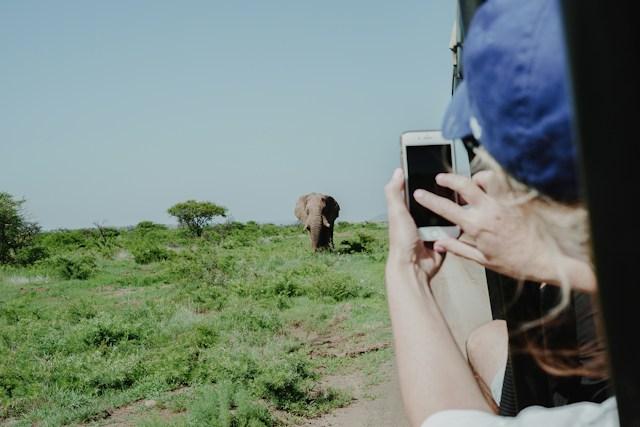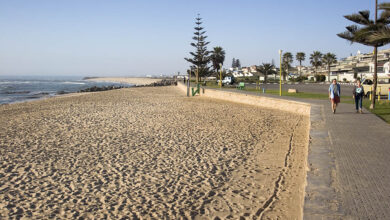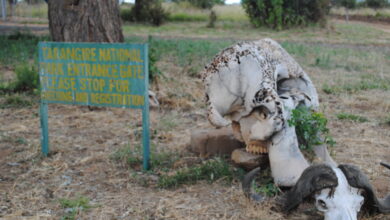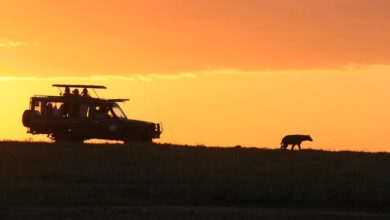Comparing Safari Experiences: Kruger National Park, Masai Mara, and Serengeti – Which Tops the List?

Discover the Rich Wildlife of Masai Mara, Serengeti & Kruger National Park
Each of these destinations is a wildlife enthusiast’s paradise, offering unique and diverse animal sightings.
Kruger National Park is renowned for its ‘Big 5’ sightings – lion, elephant, rhino, leopard, and buffalo – often all in a single day.
The Masai Mara and Serengeti, however, are famous for hosting the awe-inspiring Great Wildebeest Migration.
Masai Mara
In the Masai Mara, lions, elephants, and buffalos are commonly seen, while spotting leopards and rhinos can be more challenging due to the open landscape.
The reserve is a hotspot for observing large herds and their predators, including impressive prides of lions and cheetahs, which thrive in the open spaces. The Mara is also home to spotted hyenas, giraffes, and Thomson’s gazelles.
The best time to witness the Wildebeest Migration is from August to October. Staying in the adjacent private conservancies offers a more serene experience while still being close to the Migration.
Serengeti
The Serengeti shares many of the Masai Mara’s wildlife, with abundant lions, buffalos, elephants, and a better chance of seeing leopards in its hilly regions.
However, rhinos are increasingly rare. The Serengeti is also a haven for birdwatchers, with around 500 species. The majority of the Wildebeest Migration occurs here from November to July, offering an unparalleled wildlife spectacle.
Kruger National Park
Kruger’s private reserves, like Sabi Sands, Timbavati, and Thornybush, are excellent for Big 5 sightings, particularly leopards, which thrive in the park’s varied landscape.
It’s also the best place to spot rhinos and boasts a high elephant population. Beyond the Big 5, the park is a sanctuary for rare species like African wild dogs, cheetahs, and sable antelopes.
Birdwatchers will find a diverse array of species, including various kingfishers, lilac-breasted rollers, carmine bee-eaters, and raptors.
The Green Season, from November to April, is particularly vibrant for birdwatching due to the abundance of migrant species and plentiful food.
ALSO READ: Tourist Safety in Tanzania: A Comprehensive Guide
Exploring Safari Activities in Masai Mara, Serengeti & Kruger National Park
When visiting these iconic destinations, morning and afternoon game drives with professional guides are the primary activities.
These guides provide valuable insights into the wildlife and environment. However, the range of activities varies depending on the location, with private reserves typically offering more options than public parks, such as night drives and nature walks. Family-friendly accommodations often include activities and educational programs for children.
In exclusive lodges or private safari villas, guests might enjoy a variety of unique activities like archery, tennis, interactive cooking classes, wildlife lectures, photography workshops, guided nature walks, mountain biking, and junior ranger programs for children.
Optimal Times for Visiting Masai Mara, Serengeti, and Kruger National Park
The best time to visit these parks is generally during the dry seasons, as wildlife is more easily spotted, the climate is more comfortable, and the malaria risk is lower.
However, the high season, which coincides with the dry season, often comes with higher costs and requires earlier booking, especially for witnessing events like the Wildebeest Migration.
The Green Season, although more affordable, has its own appeal with lush landscapes, abundant birds, and many newborn animals. It’s an excellent time for photography and avoiding crowds.
Masai Mara
A year-round safari destination, the Mara experiences short rains in November and December and long rains in April and May.
The Wildebeest Migration is best seen from August to October, with August being ideal for witnessing dramatic river crossings.
The high season runs from June to October, so booking in advance is crucial. January to March is also a great time with milder weather and fewer crowds.
Serengeti
The Serengeti, too, is a year-round destination with similar rainy seasons as the Mara. The Migration moves around the park from November to July.
The calving season from February to March is particularly dramatic, offering unique wildlife viewing opportunities. The less crowded rainy seasons also offer a chance to enjoy the park more privately.
Kruger National Park
The dry season from May to October is ideal for wildlife spotting in the Kruger. This period offers comfortable weather with few mosquitoes and sparse vegetation, making animal sightings easier.
However, the park can be busy from June to August due to local school holidays. Private reserves adjacent to the park offer exclusive experiences like walking safaris.
The Green Season, from November to April, brings lush landscapes, excellent birdwatching opportunities, and vibrant wildlife activity. It’s also a great time for combining a safari with a Cape Town beach holiday.
ALSO READ: Exploring the Top Beaches in Cape Town South Africa: Your Ultimate Guide
Exploring the Top Beaches in Cape Town South Africa: Your Ultimate Guide
Understanding Safari Costs in Masai Mara, Serengeti & Kruger National Park
Embarking on an African safari is a considerable investment, so it’s essential to align your chosen destination, accommodation, and experiences with your expectations.
Generally, the more you spend, the more exclusive and private your safari experience, often enhancing the quality of wildlife viewing due to fewer vehicles and more controlled access to animal sightings.
Cost Guidelines
These are average costs per person per night, sharing a room, for high and low seasons. These figures exclude international flights, visas, and optional activities.
Masai Mara
Private conservancies in the Masai Mara and the Serengeti provide exclusive safari experiences, particularly appealing during the crowded migration periods. In the Serengeti, many visitors flock to the Mara River area, particularly during mid-year when the wildebeest migration peaks.
Kruger National Park
While Kruger is a vast public-access area suitable for self-drive safaris, adjoining private reserves like Sabi Sands, Thornybush, Timbavati, Kapama, and Klaserie offer almost guaranteed close encounters with the Big 5 in a more secluded setting.
Best Accommodation Options in Masai Mara, Serengeti & Kruger National Park
Accommodations range from luxurious villas with butler services to more traditional tents with en suite bathrooms.
Morning and afternoon game drives are standard, but many lodges also offer great wildlife viewing opportunities right from the comfort of your room, overlooking waterholes or rivers.
Masai Mara
Accommodation in the Masai Mara varies from tented camps to large lodges. The central and eastern regions are bustling during the Migration season.
Quieter, more exclusive camps are found in the northern private conservancies, offering proximity to migration hotspots but with a more peaceful retreat. Advance booking, especially for witnessing the Migration, is advised.
Serengeti
Camps in the Serengeti are often positioned along the Migration path, necessitating timing your stay with the wildebeest movements. Mobile camps that follow the herds are an option. Early booking is crucial for witnessing key events like the Grumeti and Mara River crossings.
Kruger National Park
The Kruger’s accommodation spectrum is broad, ranging from intimate hideaways perfect for honeymoons to family-friendly lodges and lavish private villas. Beyond the luxury amenities, more economical options are available, particularly appealing for families and informal camp settings.





